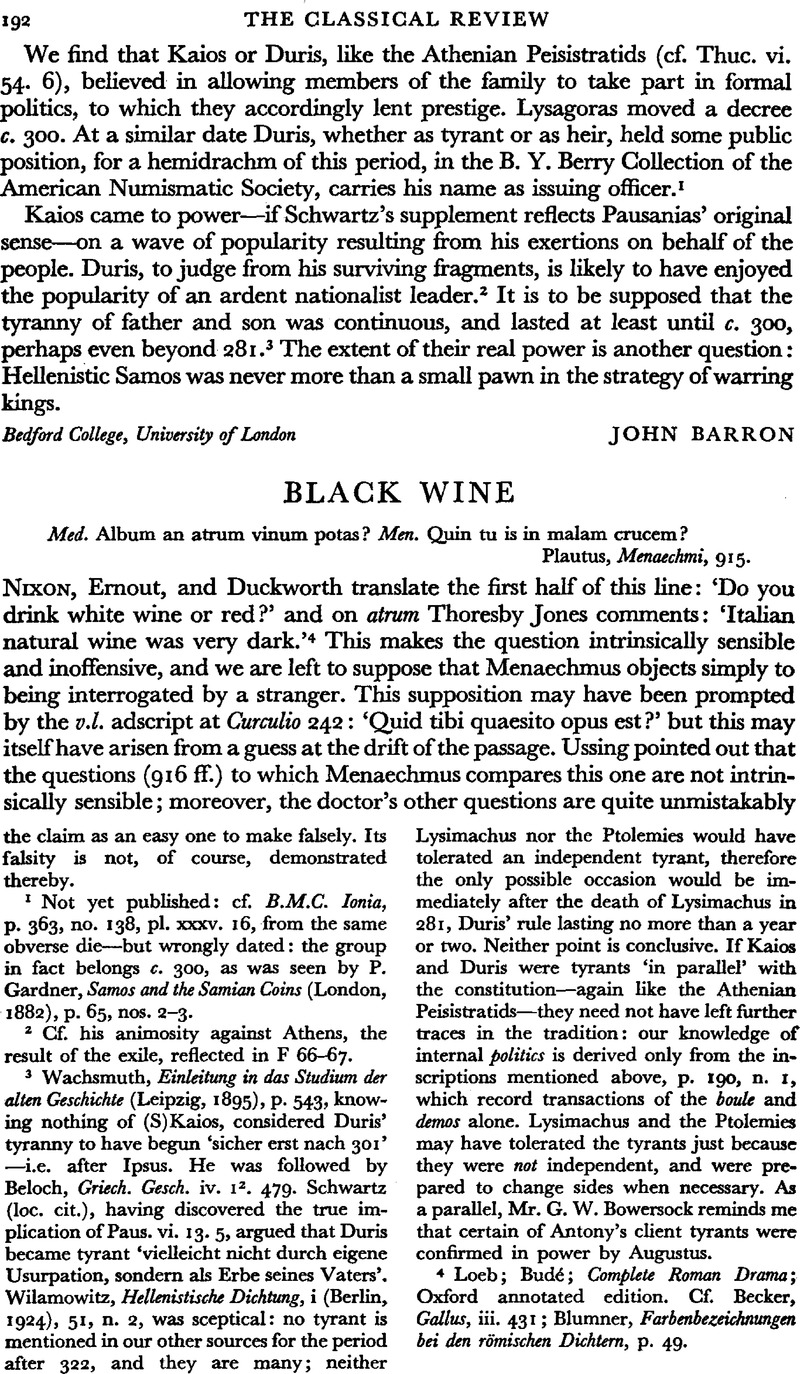No CrossRef data available.
Article contents
Black Wine
Published online by Cambridge University Press: 27 February 2009
Abstract

- Type
- Review Article
- Information
- Copyright
- Copyright © The Classical Association 1962
References
page 192 note 1 Not yet published: cf. B.M.C. Ionia, p. 363, no. 138, pi. xxxv. 16, from the same obverse die—but wrongly dated: the group in fact belongs c. 300, as was seen by Gardner, P., Samos and the Samian Coins (London, 1882), p. 65, nos. 2–3.Google Scholar
page 192 note 2 Cf. his animosity against Athens, the result of the exile, reflected in F 66–67.
page 192 note 3 Wachsmuth, , Einleitung in das Studium der alten Geschichte (Leipzig, 1895), p. 543Google Scholar, knowing nothing of (S) Kaios, considered Duris' tyranny to have begun ‘sicher erst nach 301’—i.e. after Ipsus. He was followed by Beloch, , Griech. Gesch. iv. 12. 479Google Scholar. Schwartz (loc. cit.), having discovered the true implication of Paus. vi. 13. 5, argued that Duris became tyrant ‘vielleicht nicht durch eigene Usurpation, sondern als Erbe seines Vaters’. Wilamowitz, , Hellenistische Dichtung, i (Berlin, 1924), 51, n. 2Google Scholar, was sceptical: no tyrant is mentioned in our other sources for the period after 322, and they are many; neither Lysimachus nor the Ptolemies would have tolerated an independent tyrant, therefore the only possible occasion would be immediately after the death of Lysimachus in 281, Duris' rule lasting no more than a year or two. Neither point is conclusive. If Kaios and Duris were tyrants ‘in parallel’ with the constitution—again like the Athenian Peisistratids—they need not have left further traces in the tradition: our knowledge of internal politics is derived only from the inscriptions mentioned above, p. 190, n. 1, which record transactions of the boule and demos alone. Lysimachus and the Ptolemies may have tolerated the tyrants just because they were not independent, and were prepared to change sides when necessary. As a parallel, Mr. G. W. Bowersock reminds me that certain of Antony's client tyrants were confirmed in power by Augustus.
page 192 note 4 Loeb; Budé; Complete Roman Drama; Oxford annotated edition. Cf. Becker, , Gallus, iii. 431Google Scholar; Blumner, , Farbenbezeichnungen bei den römischen Dichtern, p. 49.Google Scholar
page 193 note 1 Introduction to the Greek Theatre, p. 174.
page 193 note 2 ap. Athen. 32 d; cf. 26 c; Gellius, xiii. 30.
page 193 note 3 N.H., xiv. 80. Galen (on Hipp, de Acut. Morb. Victu iii. 1) added ξανθ⋯ς and ⋯ρυθρ⋯ς to Mnesitheus' list.
page 193 note 4 So Keats, in claiming wine as the true liquor of inspiration, calls it ‘the true, the blushful Hippocrene’. Cf. Clearchus ap. Ath. 43 f (who also contrasts it with black mulberry juice). When Homer calls the sea οἴνοψ, I suspect that he is merely indicating that water in the mass loses its white transparency and falls into a darker category.
page 193 note 5 De Fin. ii. 23; see Munro, , Journ. Phil. viii (1879), 217 ff.Google Scholar
page 193 note 6 Galen, Meth. Med. 12. 4. Either Achilles Tatius (ii. 2) or his fourth-century scribe (Jackson, , C.Q. xxix [1935], 52CrossRefGoogle Scholar) thought of Chian as ἔκλευκος ‘off-white’. Theopompus' remark (ap. Ath. 26 b) that the Chians were the first to invent dark wine only proves that dark wine was to be found on the island. For Lesbian, see Enk on Prop. i. 14. 2.
page 193 note 7 Aristophanes ap. Ath. 478 d. This may be why a flagon of Thasian is sacrificed in Lysistrata (195 ff.), for it is red wine which we liken to blood.
page 194 note 1 ii. 40. 6; viii. 55. 14; 77. 5; ix. 22. 8; xi. 8. 7; 49. 7; also C.I.L. vi. 9797.
page 194 note 2 Jardé (Daremberg–Saglio v. 915) seems to me to misunderstand the situation. White Falerno is mentioned in a citation (1884) in O.E.D.
page 194 note 3 Truc. 903 with Enk's note.
page 194 note 4 See Ussing, ad loc., who prefers, however, to understand infuscare of spoiling the taste.
page 194 note 5 Dioscorides v. 8; cf. Cato 156 and 157 for vinum atrum as a purge.
page 194 note 6 Cf. Florentinus, , Geoponica viii. 23Google Scholar. Champagne growers have even been known to desist from gathering the grapes in the midday sun for fear that the juice might be coloured.
page 194 note 7 Hipp. De Vict. Rat. ii. 223; Galen, Prob. Prav. Al. 11 and passim; Celsus ii. 29; cf. Pliny xiv. 117 for sweet Thasian as a laxative.
page 194 note 8 For example, Cato (115) recommends a laxative made by throwing a handful of black hellebore into an amphora of wine. The colouring of the hellebore root is remarkably hard to extract, but its very name might cause the result to be called vinum atrum.




